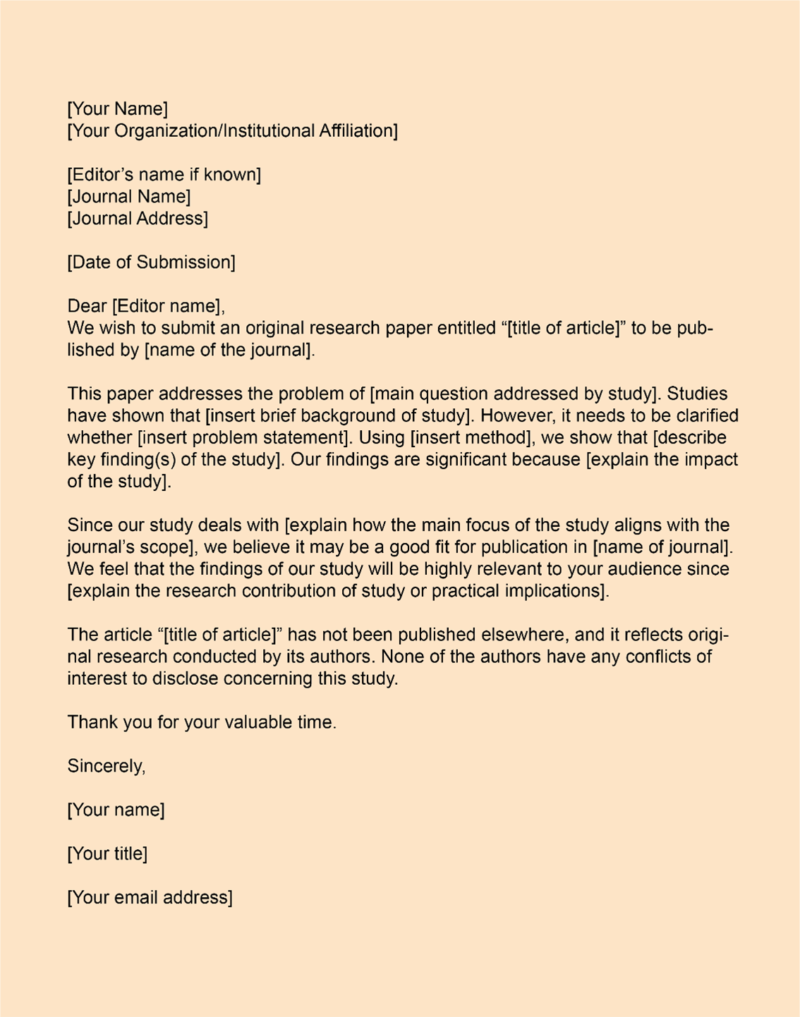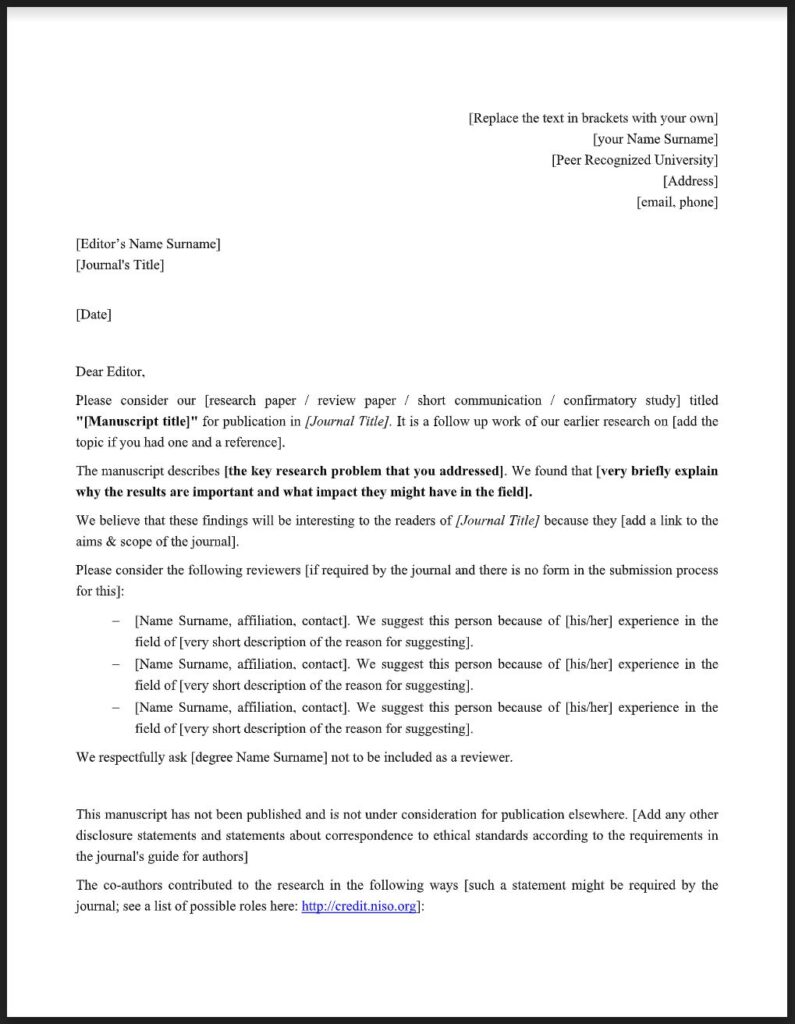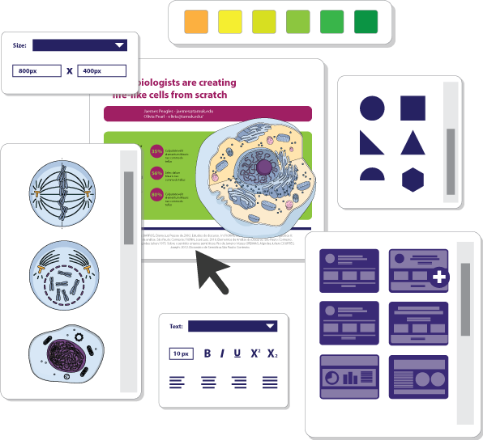- Research Process
- Manuscript Preparation
- Manuscript Review
- Publication Process
- Publication Recognition
- Language Editing Services
- Translation Services


How to Write a Cover Letter for Your Manuscript? Here are the Tips and Examples
- 3 minute read
- 22.2K views
Table of Contents
A cover letter is often the first thing an editor reads when reviewing your submission. As your first pitch to the editor, the cover letter helps them gauge the suitability of your manuscript for publication in their journal. Imagine your work shaping the future of your field, gathering citations, and sparking discussions. A powerful cover letter is thus the first step to making that vision into a reality.
In this article, we will guide you through the process of writing an effective cover letter and explain how you can get it right every time with examples. First, let us get started with the basics!
Getting the Basics Right
When writing a cover letter, it is crucial to address the editor by their correct and complete name¹ . If there are multiple co-editors, you can address your letter to the right person, based on their specialization or designated responsibilities. If unsure, it is okay to go with a more general salutation, such as “Dear Editors”¹ .
Presenting your Research
Provide a clear and concise title for your submission and specify whether it is an article, communication, review, perspective, or a manuscript belonging to some other category. If the journal guideline recommends, consider including a list of all authors in the manuscript.
After covering the preliminary information, briefly explain your paper’s central theme or focus to give the editor an idea of its contents. Ensure this stays a brief outline, without going into too much detail.
Conveying the Importance of Your Work
How you communicate the impact of your work can make or break your cover letter. To make a strong impression on the editor, articulate the significance of your research clearly, emphasizing its relevance to the field. Additionally, show how your work aligns with the journal’s scope and mission.
Including a Formal Declaration
Some journals require a set of declarations from you to ensure that your manuscript adheres to its ethical code and the larger ethical standards of scientific publishing. Here are the required declarations in a cover letter:
- Originality of work:
- Confirm that your work is original and has not been published elsewhere. This tells the editor your research is unique.
- Conflict of interest statement:
- Be clear about any potential conflicts of interest. This includes any personal, financial, or professional connections that might affect your research.
- Funding source (if applicable):
- Tell where your research funding came from, if any. This includes any support or grants from organizations.
Including Personal Suggestions for Reviewers on a Separate Page (optional)
If there is no part of the submission process that collects researcher suggestions for reviewers, and there are special requests from the researcher for reviewers (e.g., recommending the inclusion or suggesting the exclusion of a specific reviewer, etc.), you may also make a note about this in the cover letter.
Combining these five points, here is a good example of a cover letter for researchers’ reference:

(This image is intended to demonstrate the norms of formatting and tone of expression in a cover letter, it is to be used only by the researcher as a reference in writing² .)
Conclusion
A strong cover letter can go a long way in ensuring success for researchers looking to publish their manuscripts! Your cover letter is the opening act, setting the stage for how editors perceive your manuscript. So, look at it not as just another formality but as a crucial opportunity to make a strong impression.
Understanding what to include, what is optional, and what is best left unsaid can be tricky. That is where our team of experts at Elsevier Language Services can step in. We will provide personalized recommendations and expert guidance to help you craft a cover letter that perfectly complements your manuscript. Reach out to us today to make a great first impression and embark on a successful academic journey!
Reference
- Nicholas, D. (2019). How to choose a journal and write a cover letter. Saudi Journal of Anaesthesia, 13(5), 35. https://doi.org/10.4103/sja.sja_691_18
- Loyola University Chicago. (n.d.). JCSHESA Sample Cover Letter. https://ecommons.luc.edu/jcshesa/cover_letter_template.pdf

Page-Turner Articles are More Than Just Good Arguments: Be Mindful of Tone and Structure!

Submission 101: What format should be used for academic papers?
You may also like.

Publishing Biomedical Research: What Rules Should You Follow?

Writing an Effective Cover Letter for Manuscript Resubmission

Journal Acceptance Rates: Everything You Need to Know

Research Data Storage and Retention

How to Find and Select Reviewers for Journal Articles

How to Request the Addition of an Extra Author Before Publication

Paper Rejection: Common Reasons

How to Write a Journal Article from a Thesis
Input your search keywords and press Enter.

Journal Article Publication Letters
What is this handout about.
This handout offers guidance on how to write a cover letter for submitting journal manuscripts for publication.
What is a journal publication letter?
A journal publication letter, also known as a journal article submission cover letter, is a cover letter written to a peer-reviewed journal to advocate for the publication of a manuscript. Not all journals ask for a publication letter. Some see publication letters as optional, but many peer-reviewed academic journals request or require them.
What do journal publication letters typically contain?
The most basic information included in a publication letter is contact information, the name of the author(s), the title of the manuscript, and either the assurance that the manuscript being submitted has not been submitted elsewhere or a statement regarding any places the manuscript may be available. Some journals may also expect you to briefly explain your argument, outline your methodology or theoretical commitments, discus permissions and funding, and explain how your manuscript fits into the overall aims of the journal. Journals may even request the names of two or three suggested reviewers for your manuscript. A journal may require all, none, or some of this additional information. The above list is not exhaustive, but it highlights the importance of knowing the journal’s conventions and expectations.
How should I prepare to write?
Just as with any other writing project, writing publication letters involves a process. Although you may finish in as little as a few hours or a day, you might take longer if you compose multiple drafts. This section is designed to help you think through the various steps of the writing process.
Previously, we mentioned the importance of knowing the journal’s standards, but you may not find those expectations laid out clearly on the journal’s website. In fact, most journals assume that the scholars who submit a letter are well-versed in the journal’s mission. Below are some strategies for helping you determine the expectations for journal article publication letters.
Consider the standards in your field:
- See if your field’s top journals require a letter.
- Ask your advisor or mentor about their standard practices.
- Ask someone who has published recently in your field’s top journals whether a letter is standard or not.
- If submitting a letter is standard practice, ask others in your field for examples of their publication letters to see what information is typically included.
Research the specific journal:
- If you aren’t already very familiar with the journal, read a handful of recent articles to get a sense of the type and content of manuscripts the journal publishes.
- Explore the journal’s website to see what you can learn about the journal in general.
- Read the journal’s mission statement.
- Read carefully any information the journal provides for potential authors.
- If you still have questions, consider contacting one of the journal’s editors.
After completing your research, you should have a good sense of the journal’s audience and the sort of articles that appear in the journal.
Once you know the expectations for publication letters in your field and in a specific journal, revisit the reasons your manuscript is a good fit for the journal. Remember the journal has no obligation to publish your manuscript. Instead, you advocate for your scholarship and communicate why your manuscript is a good fit. Below are some questions to consider.
Consider how your manuscript fits into the publication:
- How does it use a specific methodology or framework important to the journal?
- How does it focus on themes that have been popular in recent issues?
- How does it advance a new perspective on topics typically seen in the journal?
- Does it fit with any proposed themed issues?
Consider the audience for your manuscript:
- How does your subject or your approach to it intersect with the interests of the journal’s readers?
- How does your manuscript appeal to readers outside your subfield?
- Could your manuscript reach a broader audience that could expand the journal’s readership? If so, how?
Consider how your manuscript engages with the field at large:
- How is it advancing new perspectives, approaches, or topics?
- How is it critiquing previous or current scholarship?
- How is it anticipating new directions in the field?
- How is it using a common approach in a new way?
All these questions encourage you to consider how your manuscript contributes to the field in a way that is valuable enough for a journal to publish it. Make no mistake, the cover letter is an argument for why your manuscript should be published.
Writing a draft
This section addresses two aspects of composing a cover letter draft. The first aspect is the form, and the second is the content. Think about both of these aspects when composing your draft.
Consider the form
The structure of a document can be defined as the different sections of the document and the order in which they appear. There should be an addressee and addresser, as well as the proper contact information. If possible, it should be on departmental letterhead. The letter may be as short as three sentences or as long as multiple paragraphs. But unless the writer is a senior scholar, even a longer letter should be no more than one page. Some standard features you might consider:
Addressee. If you choose or are required to write a cover letter, follow the standard format for letters in the country in which the publication is based.
- It is usually addressed to the editor unless otherwise specified.
- If you cannot find the name of the editor, it is permissible to address it to the Editor-in-Chief or Managing Editor.
- The address should be the journal’s, not the editor’s personal address or institutional address.
Font. While this category may seem trivial, font choice communicates a lot to readers.
- The goal for a letter is readability, so avoid fonts and styles that are difficult to read.
- Standard fonts include Arial or Times New Roman, usually in size 12.
Paragraphs. Again, the formatting of paragraphs aids in the readability of a letter, and an unusual paragraph format may appear unprofessional to some readers.
- Make sure that paragraphs are not indented.
- Single-space the text and justify it to the left.
- Separate paragraphs with one line of space.
Closing. Letter closings solidify your presentation as a professional. Maintain the same formality as the rest of the letter.
- Close with “sincerely,” “best regards,” or something comparably formal.
- Type your name and provide your signature.
- Include your contact information near the end.
- For a dual-authored manuscript, include the contact information for both authors.
- If the manuscript was composed by more than two authors, include only one additional author’s contact information with yours.
Consider the content
Remember that a cover letter, especially a longer one, is essentially a professional pitch for your manuscript. You ultimately need to communicate why your manuscript would be a good fit for a particular journal. Journals asking for longer cover letters want to know whether you are familiar with their audience and the journal’s mission statement. Below are some elements that you should consider when composing your letter:
Summarize the major arguments/findings of the manuscript. Make sure that you clearly explain what you discovered from your research. Connect these findings to the journal’s aims and scope. Some questions you might consider:
- Did you make new connections?
- Did you confirm previous findings?
- Did you discover new implications?
Discuss your methodology. Clarify the type of methods you used in your research. Ask yourself:
- Did you undertake a case study? A longitudinal study? A cross-sectional study?
- Is the study qualitative, quantitative, or mixed methods?
- Did you use or adapt a specific model or framework?
- Did you approach the topic using a new theoretical lens?
- Did you integrate multiple theories or theoretical frameworks?
- Did you apply a theory or method not frequently used in your subfield?
- Did you approach a theory or method in a new way?
Consider the aim of the journal. Every journal has a purpose, and most journals have a statement about the type of scholarship they feature. You might ask:
- What is the aim and scope of the journal?
- How does it present itself to the field?
- How does your manuscript fit with recent publications in the journal?
Consider the readership. Here are some questions you can ask:
- Who is the audience for the journal, and how will your manuscript appeal to them?
- Which institutions subscribe to this journal?
- How does your manuscript appeal to readers outside your subdiscipline?
- How does your manuscript appeal to people outside your discipline?
- How does it appeal to non-academic readers or professionals?
Consider the journal’s future trajectory. Research journals strive to remain relevant. In order to do so, journals often change to reflect trends in the field. Ask yourself:
- Are they attempting to expand their readership?
- Are they trying to integrate interdisciplinary approaches?
- Are they incorporating more theoretical questions or newer methodologies?
- Are they willing to critique the field?
- Would your manuscript work as a part of a special issue?
Provide context for the research . If you are writing a longer letter, explain how your research fits in both with the research in your field at large and in your subfield. Ask yourself:
- How does your work contribute to your field?
- How does it engage with current scholarship in your field or subfield?
- Does your scholarship address an oversight in the field? If so, how?
- Do you innovate in terms of the subject(s); the methodology; or the integration of fields?
- Do you address a gap in current research?
Additional considerations . Check to determine whether the journal requires any additional information. Some common expectations include:
- Comment on the type of article submitted (e.g., research article, review, case report)
- Assurances that all authors agree with the content of the manuscript
- Assurance that the corresponding author will take responsibility for informing co-authors of editorial decisions, reviews received, and any changes or revisions made
- Information about any closely related manuscripts that have been submitted for simultaneous consideration to the same or another journal
- Statements about conflicts of interest or activities that might be seen as influencing the research
- Statements regarding ethical practice
- A copy of permissions to reproduce copyrighted material or a notice that permissions are pending (if applicable)
- Names of specific reviewers from the journal who may be a good fit to read your manuscript
Possible pitfalls
Below are several other elements to keep in mind as you write your publication letter:
- Avoid using too much jargon or too many acronyms.
- Avoid over-embellishing your findings or exaggerating their significance.
- Avoid name dropping.
- Keep it simple and straightforward. Do not write a novel.
- Keep it professional. Avoid humor.
- Don’t copy text word-for-word from your manuscript.
Two templates
Below are two cover letter templates to help you visualize how form and content combine to make a strong publication letter. The templates offer guidelines for each section, but they can be modified based on the standards of your field. Use them to help you think through the elements that are most important to include in your letter.
Remember, your first draft does not have to be your last. Make sure to get feedback from different readers, especially if this is one of your first publications. It is not uncommon to go through several stages of revisions. Check out the Writing Center’s handout on editing and proofreading and video on proofreading to help with this last stage of writing.
Works consulted
We consulted these works while writing this handout. This is not a comprehensive list of resources on the handout’s topic, and we encourage you to do your own research to find additional publications. Please do not use this list as a model for the format of your own reference list, as it may not match the citation style you are using. For guidance on formatting citations, please see the UNC Libraries citation tutorial . We revise these tips periodically and welcome feedback.
American Psychological Association. n.d. “Cover Letter.” APA Style. Accessed April 2019. https://apastyle.apa.org/style-grammar-guidelines/research-publication/cover-letters.
Belcher, Wendy Laura. 2009. Writing Your Journal Article in Twelve Weeks: A Guide to Academic Publishing Success . Thousand Oaks, CA: Sage Press.
BioScience Writers (website). 2012. “Writing Cover Letters for Scientific Manuscripts.” September 29, 2012. https://biosciencewriters.com/Writing-Cover-Letters-for-Scientific-Manuscripts.aspx .
Jones, Caryn. n.d. “Writing Effective Cover Letters for Journal Submissions: Tips and a Word Template.” Think Science. Accessed August 2019. https://thinkscience.co.jp/en/articles/writing-journal-cover-letters.html .
Kelsky, Karen. 2013. “How To Write a Journal Article Submission Cover Letter.” The Professor Is In (blog), April 26, 2013. https://theprofessorisin.com/2013/04/26/how-to-write-a-journal-article-submission-cover-letter/ .
Kelsky, Karen. 2013. “Of Cover Letters and Magic (A Follow-up Post).” The Professor Is In (blog), April 29, 2013. http://theprofessorisin.com/2013/04/29/of-cover-letters-and-magic-a-followup-post/ .
Mudrak, Ben. n.d. “Writing a Cover Letter.” AJE . https://www.aje.com/dist/docs/Writing-a-cover-letter-AJE-2015.pdf .
Wordvice. n.d. “How to Write the Best Journal Submission Cover Letter.” Accessed January 2019. https://wordvice.com/journal-submission-cover-letter/ .
You may reproduce it for non-commercial use if you use the entire handout and attribute the source: The Writing Center, University of North Carolina at Chapel Hill
Make a Gift
- SpringerLink shop
Cover letters
A good cover letter can help to “sell” your manuscript to the journal editor. As well as introducing your work to the editor you can also take this opportunity to explain why the manuscript will be of interest to a journal's readers, something which is always as the forefront editors’ mind. As such it is worth spending time writing a coherent and persuasive cover letter.
The following is an example of a poor cover letter:
Dear Editor-in-Chief, I am sending you our manuscript entitled “Large Scale Analysis of Cell Cycle Regulators in bladder cancer” by Researcher et al. We would like to have the manuscript considered for publication in Pathobiology. Please let me know of your decision at your earliest convenience. With my best regards, Sincerely yours, A Researcher, PhD
Instead, check to see whether the journal’s Instructions for Authors have any cover letter requirements (e.g. disclosures, statements, potential reviewers). Then, write a letter that explains why the editor would want to publish your manuscript. The following structure covers all the necessary points that need to be included.
- If known, address the editor who will be assessing your manuscript by their name. Include the date of submission and the journal you are submitting to.
- First paragraph: include the title of your manuscript and the type of manuscript it is (e.g. review, research, case study). Then briefly explain the background to your study, the question you sought out to answer and why.
- Second paragraph: you should concisely explain what was done, the main findings and why they are significant.
- Third paragraph: here you should indicate why the readers of the journal would be interested in the work. Take your cues from the journal’s aims and scope. For example if the journal requires that all work published has broad implications explain how your study fulfils this. It is also a good idea to include a sentence on the importance of the results to the field.
- To conclude state the corresponding author and any journal specific requirements that need to be complied with (e.g. ethical standards).
TIP: All cover letters should contain these sentences:
- We confirm that this manuscript has not been published elsewhere and is not under consideration by another journal.
- All authors have approved the manuscript and agree with its submission to [insert the name of the target journal].
Submission checklist
Before submitting your manuscript, thoroughly check its quality one more time. Evaluate it critically—could anything be done better?
Be sure that:
- The manuscript follows the Instructions for Authors
- All files are in the correct file format and of the appropriate resolution or size
- The spelling and grammar are correct
- You have contact information for all authors
- You have written a persuasive cover letter
Back │ Next

Writing and formatting
In this section:
- NEW! Featured Author Support
- Language editing services
- Reproducing third party illustrative materials
- Suggesting reviewers
- Writing a cover letter
- Video abstracts
- Video: How to submit your article
The cover letter gives you the opportunity to present an overview of your manuscript to the editor.
Your cover letter should include
- The objective and approach of your research
- Any novel contributions reported
- Why your manuscript should be published in this journal
- Any special considerations about your submission
- Related papers by you and/or your fellow authors (published or under consideration)
- Previous reviews of your submission
- Previous submissions of your manuscript to that journal
- Previous communication you’ve had with journal staff
You’re encouraged to submit previous communications as they can help expedite the review process. If you have any of the following, you can submit them as ‘Supplementary file for editors only’:
- Copies of related papers
- Previous editors’ comments and your responses
- Previous reviewers’ comments and your responses
NIH Employees
If you or any of your co-authors are NIH employees, you will have to submit a completed and signed NIH Publishing Agreement and Manuscript Cover Sheet according to NIH’s Employee Procedures .

How to Write an Effective Cover Letter for Journal Submission
Craft your cover letter for journal submission the right way with our expert tips! Learn how to grab editors’ attention and stand it out.
When it comes to submitting a manuscript for publication in a journal, many authors focus solely on the quality of their research and the clarity of their writing. While these are important factors, it’s easy to overlook the role that a well-crafted cover letter can play in the submission process. A cover letter can be the key to getting your manuscript noticed by the editor and ultimately accepted for publication. In this article, we’ll explore the importance of a cover letter for journal submissions and provide tips for crafting an effective one.
What is a Cover Letter for Journal Submission?
A cover letter for journal submission is a document that accompanies a manuscript when it is submitted for publication in an academic or scientific journal. The purpose of the cover letter is to introduce the author and their work to the editor of the journal and to provide any additional information that may be relevant to the manuscript or the submission process. Furthermore, its purpose is to introduce the manuscript to the editor and provide additional information about the research and its significance. The cover letter should be concise and focused, typically no more than one page.
What Should be Included in the Cover Letter?
A cover letter should include several key elements to effectively introduce your manuscript. It’s important to personalize the letter for the specific journal, use a professional tone, and proofread carefully for errors. To make sure your cover letter is effective, there are several key elements that you should include:
Addressee’s Information and Date of Submission
Your cover letter should start with the date of submission, followed by the name and address of the editor or editorial staff who will be reviewing your manuscript. This information should be current and accurate to ensure your submission is directed to the right person.
Opening Salutation
The opening salutation of your cover letter should be professional and courteous, addressing the editor or editorial staff by name, starting with “Dear…”. Don´t forget to include the title and position of the editor you are addressing.
Purpose Statement and Administrative Information
Your cover letter should have a clear statement of the purpose of your research and the journal to which you are submitting your manuscript. You should also include any administrative information required by the journal, such as the type of manuscript (e.g. original research, review article, case report) and the number of words or pages.
Summary of Main Research Findings and Implications
One of the most important elements of your cover letter is a summary of the main findings and implications of your research. This summary should be concise and focused, highlighting the most important aspects of your research and why it is significant to the field.
Statements or Information Required by the Journal
Many journals require specific statements or information to be included in the cover letter. This may include a statement that the manuscript has not been previously published or is not under consideration for publication elsewhere, or a list of potential conflicts of interest or funding sources that may have influenced the research.
Previous Contact with the Journal
If you have had previous contact with the journal, such as submitting a previous manuscript or attending a conference sponsored by the journal, it is important to mention this in your cover letter. This information can help establish a connection between you and the editor, which may increase the chances of your manuscript being accepted.
Conflict of Interests and Financial Disclosures
It is important to disclose any potential conflicts of interest or financial disclosures that may have influenced the research. This information can help ensure transparency and maintain the integrity of the research.
Your cover letter should include a statement indicating that all authors have read and approved the manuscript and that the work is original and not plagiarized. This information can help establish the credibility of the research and the integrity of the authorship.
Suggested Reviewers
Suggested Reviewers are generally considered a best practice and are often recommended by journals. Providing a list of suggested reviewers can help to ensure that the manuscript is reviewed by individuals who have the appropriate expertise and background to evaluate the work, and can help to speed up the review process by reducing the time needed for the editor to identify potential reviewers. This can help expedite the review process and increase the likelihood of your manuscript being accepted.
Concurrent/Duplicate Submissions
An important consideration when submitting a manuscript for publication is concurrent or duplicate submissions. Concurrent submissions occur when a manuscript is submitted to more than one journal at the same time. Duplicate submissions occur when a manuscript is submitted to the same journal more than once.
In the cover letter, you should clearly state whether the manuscript has been submitted elsewhere or whether it has been previously published. If the manuscript is under consideration elsewhere, you should provide the name of the journal and the date of submission. If the manuscript has been previously published, you should provide the citation for the publication.
Closing Salutation
When closing a cover letter for journal submission, it’s important to maintain a professional and courteous tone. A common closing salutation is “Sincerely,” followed by your name. However, some alternatives that are also appropriate include “Best regards,” “Thank you for your time and consideration,” or “Respectfully.” Whichever salutation you choose, make sure it matches the tone of your letter and conveys your appreciation for the editor’s consideration.
Request to Exclude Reviewers
A request to exclude reviewers is a common feature of a cover letter for journal submission, particularly in cases where the author has concerns about potential conflicts of interest or bias that could affect the review process.
When making a request to exclude reviewers, the author should provide a clear and concise explanation of the reasons for the request and should provide specific details about any potential conflicts of interest or concerns that they may have. It is also important to note that some journals may have specific guidelines or policies regarding requests to exclude reviewers, and authors should familiarize themselves with these guidelines before making a request.
In general, it is recommended that authors provide a minimum of three to five potential reviewers who are not affiliated with the author or their institution, in order to provide a broad range of expertise and perspectives. When making a request to exclude reviewers, it is also important to provide alternative suggestions for potential reviewers who could be considered in their place.
Tips for Writing a Journal Submission Cover Letter
A well-crafted cover letter can help your manuscript stand out and increase your chances of being accepted for publication. Here are some tips for writing an effective journal submission cover letter.
One of the most important tips for writing a journal submission cover letter is to proofread it carefully. Typos, spelling errors, and grammatical mistakes can detract from the professional image you want to project. Make sure to read the letter multiple times and have someone else read it over as well to catch any errors you may have missed.
Keep the Cover Letter Brief
Another important tip is to keep the cover letter brief and to the point. The cover letter should provide a brief introduction of the manuscript and the key findings, as well as any other information that is necessary for the editor to understand the importance and relevance of the manuscript. The letter should be no more than one page in length.
Review Examples of Cover Letters
It can be helpful to review examples of cover letters for journal submissions to get an idea of the style, tone, and content that is appropriate. You can search for examples online or ask colleagues who have submitted manuscripts for publication for their advice. When reviewing examples, pay attention to the language used, the level of detail provided, and the overall organization and structure of the letter. This can help you craft a cover letter that is professional, informative, and effective.
Cover Letter Template for a Journal Article Submission
A cover letter is an important component of manuscript submission for publication in a journal. Using a template can help ensure that your cover letter includes all the necessary information and follows the proper format. Here is a guide to creating a cover letter template for a journal article submission.
The header should include your contact information, including your name, affiliation, and contact details (address, phone number, and email address), the date of submission, and the name and address of the journal.
Opening Paragraph
The opening paragraph should provide a brief introduction to the manuscript and its key findings. This paragraph should also mention the purpose of the manuscript and why it is relevant to the journal’s readership. You may also want to mention any previous correspondence or contact with the journal.
Body Paragraphs
The body of the cover letter should include several paragraphs that provide more detail about the manuscript. This may include a summary of the methods used, key results and findings, and implications for future research. You may also want to mention any notable limitations or challenges encountered during the research process.
It is also important to address any specific requirements or requests from the journal, such as a particular format for tables or figures, or specific information to be included in the manuscript. You should also mention any funding sources or conflicts of interest that may be relevant.
Closing Paragraph
The closing paragraph should reiterate the significance of the manuscript and its contribution to the field. You may also want to mention any potential reviewers for the manuscript or suggest reviewers who would be appropriate. Finally, you should include a polite and professional closing, such as “Sincerely” or “Best regards”, followed by your name and signature.

Common Expressions for Cover Letters
When writing a cover letter for journal submission, it’s important to use appropriate and professional language. Here are some common expressions that can be used in cover letters:
“We are pleased to submit our manuscript…”
“The research reported in this manuscript addresses a significant gap in the literature…”
“We believe this manuscript will be of interest to your readership because…”
“Our findings have important implications for future research in this field.”
“We would like to thank the reviewers and editors for their time and consideration.”
“We look forward to hearing from you regarding the status of our manuscript.”
“Thank you for your time and consideration.”
These expressions can be used to convey important information in a professional and concise manner. When using these expressions, it’s important to tailor them to the specific journal and to make sure they are appropriate for the content of your cover letter.
Journal Submission Tips and Hacks from the Experts
Submitting a journal article can be a challenging and sometimes frustrating process. However, by following some tips and hacks from the experts, you can increase your chances of success. Here are some tips and hacks to help you submit your article to a journal:
Choose the Right Journal
Before submitting your article, make sure you choose the right journal. Consider factors such as the journal’s scope, readership, and impact factor. Make sure your article fits with the journal’s focus and aims.
Read the Guidelines
Read the journal’s submission guidelines carefully and follow them closely. Pay attention to formatting, length, and other requirements. Failure to follow the guidelines could result in your article being rejected without review.
Get Feedback
Before submitting your article, get feedback from colleagues or mentors. Ask them to read your manuscript and provide constructive criticism. This can help you identify potential weaknesses and improve the quality of your article.
Write a Strong Abstract
Your abstract is often the first thing that editors and reviewers will read. Make sure it is clear, concise, and provides a compelling summary of your article. Highlight the key findings and implications of your research.
Use Clear and Concise Language
Use clear and concise language when writing your article. Avoid jargon, technical terms, and complex language that could be difficult for readers to understand. Write in a way that is accessible to a broad audience.
Address Reviewer Comments
If your article is rejected or requires revisions, make sure you carefully address all reviewer comments. Be thorough and professional in your responses. This can increase your chances of acceptance in future rounds of review.
Keep Records
Keep records of all correspondence with the journal, including submission dates, reviewer comments, and decisions. This can help you stay organized and keep track of the progress of your article.
High Impact And Greater Visibility For Your Work
Mind the Graph is an innovative platform designed to help scientists create high-impact visuals and increase the visibility of their work. With its user-friendly interface, customizable templates, and vast library of scientific illustrations. Mind the Graph provides scientists with a powerful tool to help them communicate their research more effectively.

Subscribe to our newsletter
Exclusive high quality content about effective visual communication in science.
Sign Up for Free
Try the best infographic maker and promote your research with scientifically-accurate beautiful figures
no credit card required
Content tags

IMAGES
VIDEO
COMMENTS
As your first pitch to the editor, the cover letter helps them gauge the suitability of your manuscript for publication in their journal. Imagine your work shaping the future of your field, gathering citations, and sparking discussions.
Learn how to write a cover letter for journal submission. Download our short cover letter sample to help your paper reach the next level.
This handout offers guidance on how to write a cover letter for submitting journal manuscripts for publication. What is a journal publication letter? A journal publication letter, also known as a journal article submission cover letter, is a cover letter written to a peer-reviewed journal to advocate for the publication of a manuscript.
A good cover letter can help to “sell” your manuscript to the journal editor. As well as introducing your work to the editor you can also take this opportunity to explain why the manuscript will be of interest to a journal's readers, something which is always as the forefront editors’ mind.
Writing a cover letter. The cover letter gives you the opportunity to present an overview of your manuscript to the editor. Your cover letter should include. The objective and approach of your research. Any novel contributions reported. Why your manuscript should be published in this journal.
A cover letter can be the key to getting your manuscript noticed by the editor and ultimately accepted for publication. In this article, we’ll explore the importance of a cover letter for journal submissions and provide tips for crafting an effective one.